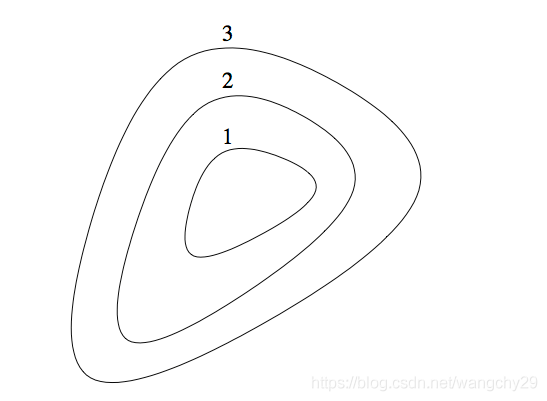水平集
1)Some level sets of a function f are shown below. The curve labeled 1 shows,etc

Which of the following properties could f have?

由图像可看出f(x)的下水平集是凸集,故函数是拟凸函数,但不能由下水平集是凸集而判断函数是凸函数还是凹函数。而函数上水平集不是凸集,故函数f(x)不是拟凹函数。
2)Now consider the following function:

Which of the following properties could f have?

从图像函数下水平集不是凸集,已知凸函数的下水平集一定是凸集,所以函数f(x)不是凸函数,故其为凹函数。而上水平集是凸集,故函数f(x)是拟凹函数。
函数和上境图
1)The epigraph of a function f is a halfspace if and only if

函数的上境图是半空间,即下图,所以函数f(x)是一个仿射函数。

2)The epigraph of a function f is a convex cone if and only if

函数f(x)的上境图是一个凸锥,所以f(x)一定是凸函数,根据凸锥的定义:,

如上图,令,此时只看z的那条射线,可知
,因为上图是f(x)的上境图,故z的射线其实就是f(x)函数在那段区间的取值,这里假设z的射线对应的x区间为
,所以
都在射线z上,
在射线z上,由锥的定义
,可知
同理可证在射线y上
综上可知
3)The epigraph of a function f is a polyhedron if and only if

因为多面体是凸集,所以f(x)的上境图是凸集,所以f(x)是凸函数。根据定义多面体是多个不等式和等式解集,几何上是有限个半空间和超平面的交集,半空间是仿射函数的上境图,多个半空间的交集,即可以是分段仿射函数的上境图。
凸性和拟凸性
For each of the following functions, determine whether it is convex, concave, quasiconvex, or quasiconcave. (Check all that apply.)
1)

证明:,故f(x)是凸函数。

上图是函数f(x)的图像,可看出其上水平集合下水平集均为凸集,故函数f(x)既是拟凸函数又是拟凹函数。
2)

证明:根据海瑟矩阵
可判断函数集不是凸函数也不是凹函数。
看其下水平集:
即
当时,上式
,所以下水平集不是凸集
而上水平集是凸集,故函数是拟凹函数。
3)

证明:正定,所以函数f(x)是凸函数,所以函数f(x)也是拟凸函数。
4)

证明:
,既不是半正定也不是半负定,所以既不是凸函数也不是凹函数。
看其下水平集
所以上水平集是凸集,所以函数是拟凸函数。同理可证下水平集也是凸集,函数是拟凹函数。
一般向量组成规则
h is nondecreasing in the ith argument, and is convex
h is nonincreasing in the ith argument, and is concave
is affine.
Fill in the blanks in the proof below to show that f is convex. (This composition rule subsumes all the ones given in the book and is the one used in software systems such as CVX.) Assume that ; the result also holds in the general case when the monotonicity conditions above are imposed on
, the extended-valued extension of h.
proof:
The correct inequalities in the above equations are

根据仿射函数,凸函数和凹函数的定义,上述答案是显然的。
The second line holds since, for i=p+1,…,q, we have _ the ith argument of h, which is (by assumption) nondecreasing in the ith argument, and for i=q+1,…,k, we have _ the ith argument, and h is nonincreasing in these arguments. The third line follows from _.
The correct phrases that fill the blank spots are

共轭函数
What is the conjugate function of on
?

根据共轭函数的定义:,因为
,这里对
求偏导,当
时,得到
,令其为0,
得到
,当
时,
,令其为0得到
,所以y是一个向量只在
的i分量为1,其他分量为0,所以选A。





















 3万+
3万+











 被折叠的 条评论
为什么被折叠?
被折叠的 条评论
为什么被折叠?








